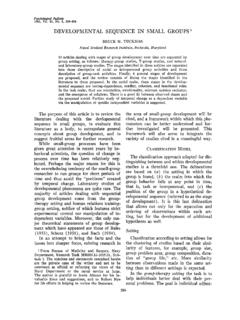Transcription of Information Systems Classification - unibz
1 1 Information Systems ClassificationEvolution of Information System The first business application of computers (in the mid- 1950s) performed repetitive, high-volume, transaction-computing tasks. The computers crunched numbers summarizing and organizing transactions and data in the accounting, finance, and human resources areas. Such Systems are generally called transaction processing Systems (TPSs)2 Evolution of IS Management Information Systems (MISs):these Systems access, organize, summarize and display Information for supporting routine decision making in the functional areas. Office Automation Systems ( OASs):such as word processing Systems were developed to support office and clerical of IS Decision Support Systems :were developed to provide computer based support for complex, nonroutine decision.
2 End- user computing:The use or development of Information Systems by the principal users of the Systems outputs, such as analysts, managers, and other of IS Intelligent Support System (ISSs):Include expert Systems which provide the stored knowledge of experts to nonexperts, and a new type of intelligent system with machine- learning capabilities that can learn from historical cases. Knowledge Management Systems :Support the creating, gathering, organizing, integrating and disseminating of organizational of IS Data Warehousing:A data warehouse is a database designed to support DSS, ESS and other analytical and end-user activities. Mobile Computing: Information Systems that support employees who are working with customers or business partners outside the physical boundaries of their company; can be done over wire or wireless networks.
3 4 Classification of Information SystemsThe two most common classifications are: Classification by breath of support Classification by organizational level Classification by Breath of SupportTypical Information Systems that follow the hierarchical organization structure are functional (departmental), enterprise wide and interorganizationalFunctional Information Systems are organized around the traditional Information Systems serve several department or the entire Systems connect two or more ChainAn organization s supply chain describes the flow of materials, Information , money and services from raw material suppliers through factories and warehouses to the end types of software solutions for managing supply chain activities.
4 Enterprise Resource Planning (ERP)Supply Chain Management (SCM)Customer Relationship Management (CRM)Departmental, Corporate, and Interorganizational IS6IT outside your organizationClassification by Organization LevelThe typical enterprise is organized hierarchically, with the clerical and office worker layer, the operational layer, the managerial layer, the knowledge worker layer and finally the strategic Information Systemsstrategicapexoperating coremiddlelinesupportstafftechno-structu reexecutive ISgeographic ISdecision supportfactoryautomation(CIM)artificial intelligencetransaction processingThe Clerical Level Clerical workers constitute a large class of employee who support managers at all levels of the company.
5 Among clerical workers, those who use, manipulate, or disseminate Information are referred to as data workers. These employees include bookkeepers, secretaries who work with word processors, and electronic file Operational LevelOperational or first- line managers deal with the day-to day operations of the organization, making routine decision, which deal in general with activities such as short- term planning, organizing, and Knowledge-Work LevelThey act as advisors and assistants to both top and middle management and are often subject-area experts. Many of these professional workers are classified as knowledge workers, people who create Information and knowledge as part of their work and integrate it into the Strategic LevelTop-level or strategic managers (the executive) make decisions that deal with situations that may significantly change the manner in which business is done.
6 Management Support Systems (MSSs)Major IT technologies designed to support managers; decision support Systems , executive support Systems , groupware technologies and intelligent Support Systems (DSS)Computer-based Information Systems that combine models and data in an attempt to solve semi-structured and some unstructured problems with extensive user Characteristics & CapabilitiesSensitivity analysis. The study of the impact that changes in one (or more) parts of a model have on other study of the impact of a change in the assumptions (input data) on the proposed analysis. Study that attempts to find the value of the inputs necessary to achieve a desired level of Structure and ComponentsData management subsystem Model management subsystem User interfaceUsersKnowledge-based subsystemsDSS Computing Environment 12 Emerging Types of DSS Frontline decision making.
7 The process by which companies automate the decision processes and push them down into the organization and sometimes out to Decision Support. The Systems that supports business decisions that must be made at the right time and frequently under time pressure. Group Decision Support SystemsVirtual group. A group whose members are in different decision support system (GDSS).An interactive computer-based system that supports the process of finding solutions by a group of decision makers. Decision room. A face-to-face setting for a group DSS, in which terminals are available to the Support SystemsOrganizational decision support system (ODSS): A DSS that focuses on an organizational task or activity involving a sequence of operations and decision Information system (EIS): A computer-based technology designed in response to the specific needs of executive support system (ESS).
8 The Capabilities of an ESS Reports that highlight deviations larger than certain thresholds. Reports may include only deviations. Based on the concept of management by reporting Analysis made any time. Upon demand and with any desired factorsand analysisShort, medium, and long term trend of KPIs or metrics, which are projected using forecasting analysisThe latest data available on KPI or some other metric, ideally in real specific measures of CSFs. The factors most critical for the success of business. These can be organizational, industry departmental, to go to details, at several levels; can be done by a series of menus or by direct queries (Using intelligent and natural language processing )Description Status access Key Performance Indicators (KPIs)Critical Success Factors (CSF)Drill-down Capability14 Expert Systems (ES)A computer system that attempts to mimic human experts by applying reasoning methodologies or knowledge in a specific and knowledge Expertise is the extensive, task-specific knowledge acquired from training, reading and experience.
9 The transfer of expertise from an expert to computer and then to the user involves four activities:Knowledge acquisition:Knowledge is from experts or from documented representation:Acquired knowledge is organized as rules or frames (objective-oriented) and stored electronically in a knowledge inferencing:Given the necessary expertise stored in the knowledge base, the computer is programmed so that it can make inferences. The reasoning function is performed in a component called the inference engine, which is the brain of transfer:The inferred expertise is transferred to the user in the form of a of Expert Systems ESs can quickly diagnose faster than humans and prescribe repairs.
10 Reduce downtimeESs usually can make faster decision than humans working decision-making time ESs allow the integration of expert judgment into analysis ( , diagnosis of machine malfunction and even medical diagnosis).Enhancement of decision- making and problem-solving capabilitiesThe explanation facility of an ES can serve as a teaching device and knowledge base for of training Even with answer of don t know an ES can produce an answer, though it may not be a definite to work with incomplete or uncertain Information ESs do not become tired or bored, call in sick or go on strike. They consistently pay attention to ESs can increase the productivity of help desk employee, or even automate this to knowledge and help desksSensors can collect Information that an ES interprets, enabling human workers to avoid hot, humid, or toxic from anywhere in the world can be obtained and used.





